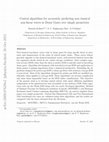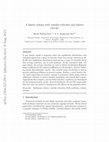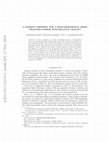Papers by Raghurama Rao Suswaram
arXiv (Cornell University), Mar 26, 2017
International Journal of Advances in Engineering Sciences and Applied Mathematics, Oct 11, 2021
arXiv (Cornell University), Sep 4, 2020

ArXiv, 2020
Non-classical non-linear waves exist in dense gases at high pressure in the region close to a the... more Non-classical non-linear waves exist in dense gases at high pressure in the region close to a thermodynamical critical point. These waves behave precisely opposite to the classical non-linear waves (shocks and expansion fans) and do not violate entropy conditions. More complex EOS other than the ideal or perfect gas equation of state (EOS) is used in describing dense gases. Algorithm development with non-ideal/real gas EOS and application to dense gasses is gaining importance from a numerical perspective. Algorithms designed for perfect gas EOS can not be extended directly to arbitrary real gas EOS with known EOS formulation. Most of the algorithms designed with prefect gas EOS are modified significantly when applied to real gas EOS with the known formulation. These algorithms can become complicated and some times impossible based on the EOS under consideration. The objective of the present work is to develop central solvers with smart diffusion capabilities independent of the eigen...
ArXiv, 2021
Simple and robust algorithms are developed for compressible Euler equations with stiffened gas eq... more Simple and robust algorithms are developed for compressible Euler equations with stiffened gas equation of state (EOS), representing gaseous mixtures in thermal equilibrium and without chemical reactions. These algorithms use fully conservative approach in finite volume frame work for approximating the governing equations. Also these algorithms used central schemes with controlled numerical diffusion for this purpose. Both Mass fraction (Y ) and based models are used with RICCA and MOVERS+ algorithms to resolve the basic features of the flow fields. These numerical schemes are tested thoroughly for pressure oscillations and preservation of the positivity of mass fraction at least in the first order numerical methods. Several test cases in both 1D and 2D are presented to demonstrate the robustness and accuracy of the numerical schemes.
International Journal of Advances in Engineering Sciences and Applied Mathematics, 2021

Computers & Fluids
A new kinetic model is proposed where the equilibrium distribution with bounded support has a ran... more A new kinetic model is proposed where the equilibrium distribution with bounded support has a range of velocities about two average velocities in 1D. In 2D, the equilibrium distribution function has a range of velocities about four average velocities, one in each quadrant. In the associated finite volume scheme, the average velocities are used to enforce the Rankine-Hugoniot jump conditions for the numerical diffusion at cell-interfaces, thereby capturing steady discontinuities exactly. The variable range of velocities is used to provide additional diffusion in smooth regions. Further, a novel kinetic theory based expression for relative entropy is presented which, along with an additional criterion, is used to identify expansions and smooth flow regions. Appropriate flow tangency and far-field boundary conditions are formulated for the proposed kinetic model. Several benchmark 1D and 2D compressible flow test cases are solved to demonstrate the efficacy of the proposed solver.
arXiv (Cornell University), Nov 13, 2021
A lattice Boltzmann scheme that is close to pure upwind, low diffusive and entropy satisfying Eng... more A lattice Boltzmann scheme that is close to pure upwind, low diffusive and entropy satisfying Engquist-Osher scheme has been formulated for hyperbolic scalar conservation laws. A model for source terms, with scalar conservation laws, is introduced to remove the numerical imbalance between convection and source terms.

Applied Mathematics and Computation, 2022
The nonlinear convection terms in the governing equations of compressible fluid flows are hyperbo... more The nonlinear convection terms in the governing equations of compressible fluid flows are hyperbolic in nature and are nontrivial for modelling and numerical simulation. Many numerical methods have been developed in the last few decades for this purpose and are typically based on Riemann solvers, which are strongly dependent on the underlying eigen-structure of the governing equations. Objective of the present work is to develop simple algorithms which are not dependent on the eigen-structure and yet can tackle easily the hyperbolic parts. Central schemes with smart diffusion mechanisms are apt for this purpose. For fixing the numerical diffusion, the basic ideas of satisfying the Rankine-Hugoniot (RH) conditions along with generalized Riemann invariants are proposed. Two such interesting algorithms are presented, which capture grid-aligned steady contact discontinuities exactly and yet have sufficient numerical diffusion to avoid numerical shock instabilities. Both the algorithms presented are robust in avoiding shock instabilities, apart from being accurate in capturing contact discontinuities, do not need wave speed corrections and are independent of eigen-strutures of the underlying hyperbolic parts of the systems.
Computers & Fluids
A low diffusive flux difference splitting based kinetic scheme is developed based on a discrete v... more A low diffusive flux difference splitting based kinetic scheme is developed based on a discrete velocity Boltzmann equation, with a novel three velocity model. While two discrete velocities are used for upwinding, the third discrete velocity is utilized to introduce appropriate additional numerical diffusion only in the expansion regions, identified using relative entropy (Kullback-Liebler divergence) at the cell-interface, along with the estimation of physical entropy. This strategy provides an interesting alternative to entropy fix, which is typically needed for low diffusive schemes. Grid-aligned steady discontinuities are captured exactly by fixing the numerical diffusion such that flux equivalence leads to zero numerical diffusion across discontinuities. Results for benchmark test problems are presented for inviscid and viscous compressible flows.

ArXiv, 2019
In this contribution, we study a stability notion for a fundamental linear one-dimensional lattic... more In this contribution, we study a stability notion for a fundamental linear one-dimensional lattice Boltzmann scheme, this notion being related to the maximum principle. We seek to characterize the parameters of the scheme that guarantee the preservation of the non-negativity of the particle distribution functions. In the context of the relative velocity schemes, we derive necessary and sufficient conditions for the non-negativity preserving property. These conditions are then expressed in a simple way when the relative velocity is reduced to zero. For the general case, we propose some simple necessary conditions on the relaxation parameters and we put in evidence numerically the non-negativity preserving regions. Numerical experiments show finally that no oscillations occur for the propagation of a non-smooth profile if the non-negativity preserving property is satisfied.

Journal of Computational Physics, 2020
In this study, we analyze convection-pressure split Euler flux functions which contain genuine we... more In this study, we analyze convection-pressure split Euler flux functions which contain genuine weakly hyperbolic convection subsystems. A system is said to be a genuine weakly hyperbolic if all eigenvalues are real with no complete set of linearly independent (LI) eigenvectors. To construct an upwind solver based on flux difference splitting (FDS) framework, we require to generate complete set of LI eigenvectors. This can be done through addition of generalized eigenvectors which can be computed from theory of Jordan canonical forms. Once we have complete set of LI generalized eigenvectors, we construct upwind solvers in convection-pressure splitting framework. Since generalized eigenvectors are not unique, we take extra care to ensure no direct contribution of generalized eigenvectors in the final formulation of both the newly developed numerical schemes. First scheme is based on Zha and Bilgen type splitting approach, while second is based on Toro & Vázquez splitting. Both the schemes are tested on several benchmark test problems on 1-D and one of them is tested on some typical 2-D test problems which involve shock instabilities. The concept of generalized eigenvector based on Jordan forms is found to be useful in dealing with the genuine weakly hyperbolic parts of the considered Euler systems.
International Journal of Advances in Engineering Sciences and Applied Mathematics, 2015
A simple and accurate central scheme in finite volume framework is developed for systems of hyper... more A simple and accurate central scheme in finite volume framework is developed for systems of hyperbolic conservation laws, using a splitting of strongly hyperbolic and weakly hyperbolic parts. This leads to the flux function of 1D inviscid Euler compressible system being split into convection and pressure parts and 1D inviscid shallow water system into convection and celerity parts. The numerical diffusion is fixed based on flux equivalence principle, which leads to the satisfaction of the jump conditions. The numerical scheme is tested on various shock tube problems of gas dynamics for 1D Euler equations and on dam breaking problems for shallow water equations. Comparison is done with an approximate Riemann solver to demonstrate the efficiency of the numerical method.

Notes on Numerical Fluid Mechanics and Multidisciplinary Design, 2013
In this paper we present a kinetic relaxation scheme for the Euler equations of gas dynamics in o... more In this paper we present a kinetic relaxation scheme for the Euler equations of gas dynamics in one space dimension. The method is easily applicable to solve any complex system of conservation laws. The numerical scheme is based on a relaxation approximation for conservation laws viewed as a discrete velocity model of the Boltzmann equation of kinetic theory. The discrete kinetic equation is solved by a splitting method consisting of a convection phase and a collision phase. The convection phase involves only the solution of linear transport equations and the collision phase instantaneously relaxes the distribution function to an equilibrium distribution. We prove that the first order accurate method is conservative, preserves the positivity of mass density and pressure and entropy stable. An anti-diffusive Chapman-Enskog distribution is used to derive a second order accurate method. The results of numerical experiments on some benchmark problems confirm the efficiency and robustness of the proposed scheme.

16th AIAA Computational Fluid Dynamics Conference, 2003
Using the framework of a Relaxation System, which converts a non-linear conservation law into a s... more Using the framework of a Relaxation System, which converts a non-linear conservation law into a system of linear convection equations with non-linear source terms, an accurate shock capturing algorithm is developed for the numerical simulation of hyperbolic conservation equations. The basic idea is to formulate a nite volume method with open coecients of numerical dissipation for the discrete Boltzmann equation and compare the resulting relaxed scheme with Rankine-Hugoniot condition for xing the coecients of numerical dissipation. Since the Rankine-Hugoniot condition is satised by the discretized scheme, the steady discontinuities are captured exactly, like Roe’s approximate Riemann solver. The features of this Accurate Shock Capturing Algorithm with a Relaxation System (ASCARS) are demonstrated by applying it to some standard bench-mark problems.

Lecture Notes in Physics
ABSTRACT A new upwind Boltzmann scheme termed Peculiar Velocity based Upwind (PVU) method is deve... more ABSTRACT A new upwind Boltzmann scheme termed Peculiar Velocity based Upwind (PVU) method is developed for solving Euler equations. Upwinding is done based on peculiar velocity of Kinetic Theory of Gases. This new method is more efficient and physically more meaningful than its predecessor, the Kinetic Flux Vector Splitting (KFVS) method. The PVU method is applied to some standard test problems. The results demonstrate the soundness of the new idea. The motivation for this work came from the idea of improving the Kinetic Flux Vector Splitting (KFVS) method [1] which was demonstrated to be very robust by its application to a wide variety of 2-D and 3-D problems using structured and unstructured meshes [2,3,4,5]. In the KFVS method upwinding is done based on whether molecular velocity is greater or less than zero. Here, a new upwind Boltzmann scheme, in which upwinding is done based on peculiar velocity, which is the relative velocity of the molecule with respect to the fluid, is presented. The upwind method for Euler equations is obtained by taking moments of the upwind scheme applied to the Boltzmann equation of Kinetic Theory of Gases.
Lecture Notes in Physics
... Using Peculiar Velocity Based Upwind (PVU) Method MZDauhoo 1, SVRaghurama Rao 2,4, V.Ramesh 3... more ... Using Peculiar Velocity Based Upwind (PVU) Method MZDauhoo 1, SVRaghurama Rao 2,4, V.Ramesh 3 and SMDeshpande 4 1Dept. ... E-mail : raghu@itwm.uni-kl.de 3National Aerospace Laboratories, PB 1779, Bangalore-560 017, India. E-mail : vramesh @aero. iisc. ...

Uploads
Papers by Raghurama Rao Suswaram